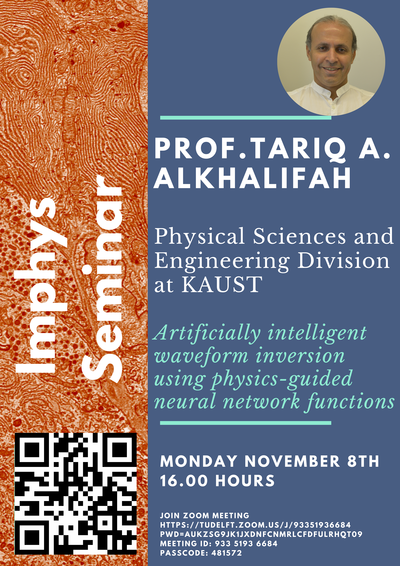ImPhys Colloquium | Tariq A. Alkhalifah | Nov 8
08 November 2021 16:00 till 17:00 | Add to my calendar
Tariq A. Alkhalifah is a professor in the Physical Sciences and Engineering Division. He joined KAUST in June 2009. Before he joined KAUST, Alkhalifah was research professor and director of the Oil and Gas Research Institute at King Abdulaziz City for Science & Technology (KACST). Previously, he held the positions of associate research professor, assistant research professor, and research assistant at KACST. From 1996 to 1998, Alkhalifah served as a postdoctoral researcher for the Stanford Exploration Project at Stanford University, United States. He received the J. Clarence Karcher Award from the Society of Exploration Geophysicists (SEG) and the Conrad Schlumberger Award from the European Association for Geoscientists & Engineers (EAGE) in 2003, and honorary lecturer for the SEG in 2011. Alkhalifah is a member of SEG and of EAGE. Alkhalifah received his doctoral degree in geophysics and his master’s degree in geophysical engineering, both from the Colorado School of Mines, United States. He holds a bachelor’s degree in geophysics from King Fahd University of Petroleum and Minerals, Saudi Arabia.
Artificially intelligent waveform inversion using physics-guided neural network functions
Neural network models, in simple terms, are nothing but mathematical functions of the inputs. Unlike functions represented by Fourier, wavelet or any other basis functions, the parameters (coefficients) of the neural networks correspond to basis functions defined primarily by a stack of linear operations and activation functions. Thus, these parameters are evaluated through an optimization problem, and neural network models have proven to be good universal function approximators, granted the functions are continuous, like those describing wavefields, including our data. I will share examples of neural network functions that help us solve some of the outstanding challenges we face in waveform inversion. These include an NN misfit function, trained to measure the distance between the observed and synthetic data in a way that allows us to avoid cycle skipping. It also includes an NN wavefield functional solution to the wave equation that can also fit the data. The key feature of NN functions is their flexibility as they are optimized to implement specific tasks, and in our case these tasks are directed to support waveform inversion.
Meeting ID: 933 5193 6684
Passcode: 481572
One tap mobile
+12532158782,,93351936684# US (Tacoma)
+13017158592,,93351936684# US (Washington DC)
Dial by your location
+1 253 215 8782 US (Tacoma)
+1 301 715 8592 US (Washington DC)
+1 312 626 6799 US (Chicago)
+1 346 248 7799 US (Houston)
+1 646 558 8656 US (New York)
+1 669 900 9128 US (San Jose)
Meeting ID: 933 5193 6684
Find your local number: tudelft.zoom.us/u/aduLR103Is
Join by Skype for Business
